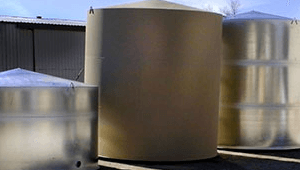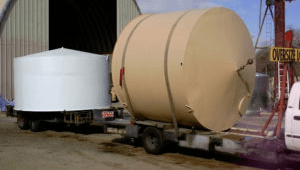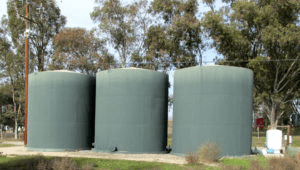(805)238-4431



Each tank is manufactured to your unique needs. If you have a low gallons per minute producing well tank that holds between 5000 and 10000 gallons is going to suit your needs.
We work with you to calculate the most efficient size tank.
The equation for calculating tank size is the square feet of the house x 10/7. For a 2000 sq ft house: ((2000 x 10 = 20,000)/7= 2,857 gallons)).
In addition to the estimated water usage for the household, the minimum water storage for fire suppression also needs to be calculated into the total. Tanks that hold from 5000 to 10000 are the most common.
California requires a minimum-size water storage tank for fire suppression. The best thing is to call your local building department to find out what the local requirements are for a water storage tank for fire suppression.
Our tanks are designed to meet fire suppression requirements.
We generally deliver within two to three weeks. However specific needs are taken into account. We make every possible effort to meet reasonable immediate delivery needs.
We give you the delivery cost when you order the tank.
We deliver anywhere in California. Our 4-wheel drive vehicles can deliver to some of the most remote and rugged terrain. In most cases, we can set and position the tank precisely as you want.
We recommend tank coating if the pH of the water is less than 7, which is the neutral point. Below 7pH the water is acidic. The galvanized steel offers some protection, but the interior epoxy coating is a much more effective method of protecting the tank against corrosion.
All fittings through up to 4 inches are included in the price of the tank unless someone asks for too many. We give you the cost of fittings above 4 inches NPT.
Four-inch fittings are the most common for a fire hydrant line. When you place your order we ask you what fittings you want and where you want them.
In most cases, we are ready to deliver your tank within two weeks of the order.
Yes. Galvanized steel is a top choice for storing potable water. Adding an optional epoxy lining helps preserve the quality of the water as well as adding an extra of layer of protection for the tank.
All of our tanks include a 10-year guarantee for quality of fabrication and workmanship.
Yes. Our tanks comply with the standards for their intended use. Engineering specifications are available for all of our tanks, including specifications for the pad the tanks are set on.
Delivering and seating the tank is part of the service we offer.
Yes. We offer water level gauges, fittings, and gravel rings. We also paint the exterior in most any desired color and offer optional interior epoxy coating.
Yes. We manufacture all of our tanks to the customer’s specifications.